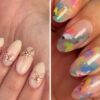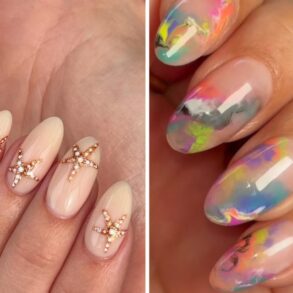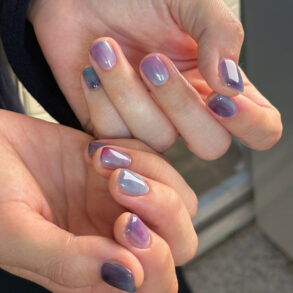Once a trade secret and now taken off thanks to TikTok, the Russian Manicure is all over the place. The precise, abrasive manicure technique is known for creating a flawless, clean result. But, while this grooming technique is surging in popularity, becoming a trending Google search late last year, not everyone is on board.
Some argue that the Russian Manicure has an increased potential to cause problems and requires very specific protocols to remain hygienic. Others are quick to point out that trained professionals with experience get consistently good results. We’re diving deep through the hype to determine what makes the Russian Manicure unique, the risks and how to approach getting one safely.
Featured Experts
- Hadley King, MD is a dermatologist based in New York City
- Kendall Egan, MD is a dermatologist based in Wilmington, NC
- Anastasia is a manicurist at Nashy Nails Studio in Denver, CO
What Is a Russian Manicure?
According to New York dermatologist Hadley King, MD, a proper Russian manicure is a waterless technique that involves heavy cuticle work. Using e-files and cutting, the cuticle is almost entirely removed in a Russian manicure to create a clean, elegant look with no excess skin around the edges.
-
The cuticle is carefully prepped. -
Delicate drill filing is performed. -
The nails are primed for extensions.
Not many dermatologists would suggest cutting away the cuticle or the layer just beyond, the eponychium. “The eponychium and cuticles help to seal the transition zone between the skin and the nails,” Dr. King says. “This barrier helps to keep out microbes and irritants, and helps to seal in moisture.” Both the cuticle and the eponychium are critical to protecting against things like bacteria.
Wilmington, NC dermatologist Kendall Egan, MD explains that the cuticles play a role in our nail health. “Nails are made of keratin and can dry out like your hair with washing,” she explains. “Healthy cuticles will decrease the risk of bacteria and fungal nail infections.”
It’s even illegal in some states to remove the cuticle without a medical license, making this manicure unattainable in some areas of the country, including Alabama, Texas and California. The risks of short-term skin damage and the micro-cuts caused by the electric drill serving as an entryway for bacteria are serious concerns, but some experts have also raised the flag on the potential for long-term nail and even nerve damage for repeat customers.
That said, if you’ve ever wondered why your manicure doesn’t look as clean and sharp as an advertising image, the Russian manicure is the answer. The precise work and removal of the cuticle is what creates the almost unreal final result and why the appeal is so high.
Manicurists like Denver, CO manicurist Anastasia of Nashy Nails Studio, who has been performing the Russian manicure for over 15 years, note that the key to consistently safe results is a dedicated hygienic practice. Additionally, the process of a Russian manicure is best handled by professionals who understand a delicate hand is necessary to prevent nail damage.
What Makes it Different?
“There are multiple benefits to a Russian manicure,” says Anastasia. “The beauty of the nails, the longevity of the look and the benefits to not soaking off gel polish and using a machine to remove product but not all the way to the nail plate which in our experience helps promote stronger, healthier natural nails.”
“A Russian manicure is a dry manicure (no water is used) that uses an electric file (a “nail drill”) to file away cuticles,” Dr. King explains. In fact, the cuticle isn’t where the snipping stops. “The electric file is even used to open up the eponychium to thoroughly remove dead skin in the area. It’s also called a dry e-file manicure.”
The detailed cuticle work and careful prep are key features of the Russian manicure, which is typically completed with gel extensions. The very thing that makes this manicure special is what has dermatologists concerned.
“It’s important to keep the skin around the nails well moisturized to optimize the skin barrier function so that bacteria and other pathogens are less likely to penetrate and cause infection,” Dr. King explains. “An electric file would compromise the seal provided by the cuticles and eponychium, thus increasing the risk of infection and contributing to loss of moisture.”
Alongside the cuticle work, not using water at all is a key difference.
Many manicures involve soaking in water at several points during the process. The Russian manicure, though, remains dry precisely because they are opening the cuticle. Even clean-looking water contains a ton of different little microbes, and keeping them away from your newly snipped or buffed cuticles is critical for preventing an infection.
-
After the dry manicure, gel is applied. -
The cuticle work allows for a close gel application. -
The final result is a short, clean style.
How Much Does a Russian Manicure Cost?
According to Frida Beauty Collective facial and eyebrow bar, a dry Russian manicure typically costs between $70-$90 without nail art. Additional costs may be incurred with the addition of intricate design work. This is a little above a traditional manicure cost given the amount of detail work. The manicure itself will also take more time to complete.
After the cuticle is buffed, cleaned and carefully snipped away, the nail itself is buffed with a drill into the correct shape. If you’re not getting nail extensions, your nail is then given a base coat and a color/design of your choice. No soaking should take place at any point during a Russian manicure.
You may also be curious as to how long a Russian manicure is meant to last. Because the cuticle work allows for gel nails to be placed precisely, they last on average two weeks longer than traditional gel nails.
Are Russian Manicures Safe?
Your manicurist can take steps to ensure your risk is low, including stringent hygienic practices. Along the same lines, looking for red flags like the ones pointed out by TikTok user isabelle.lux will help keep you protected. That includes making sure the entire process is waterless and that your tech uses only nail gel meant to work with this kind of manicure.
That said, ultimately, when you open the cuticle like this, you’re taking a risk. “Yes, cleanliness and exact technique are important,” Dr. King says. “But the idea is to file away the cuticle and open the eponychium, and this compromises the seal and increases risk of infection and contributes to loss of moisture.”
If you’re set on pursuing a Russian manicure, your best bet is to look for someone experienced in the practice. Salons that offer this manicure shouldn’t do so lightly, and you should be prepared to halt the process if any of the above red flags occur.
“When looking for a quality Russian manicure it is important to verify that it is a dry manicure and where the nail tech received their training,” says Anastasia. “E-files used without proper training can be dangerous so verifying proper training and certifications is important.”
Dr. King agrees. “I would recommend doing your homework to find a technician who is licensed and experienced and who abides by all hygienic standards,” Dr. King says.
This post was originally published on this site be sure to check out more of their content.







